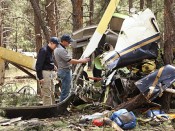Expert: Air-Ambulance Helicopter Crews Most Likely to Die in Crashes
By Alan Levin, USA TODAY – WASHINGTON
 Air-ambulance helicopters have the worst fatal crash record in aviation, and their crews are among the most likely to die on the job, an expert told a panel of federal investigators Tuesday.
Air-ambulance helicopters have the worst fatal crash record in aviation, and their crews are among the most likely to die on the job, an expert told a panel of federal investigators Tuesday.
The rate of fatalities per 100,000 air-ambulance employees over the past 10 years exceeds other dangerous professions such as logging or deep-sea fishing, said Ira Blumen, program director of the University of Chicago Aeromedical Network.
Blumen’s comments came during the first day of a hearing by the National Transportation Safety Board (NTSB), which is examining the industry’s burgeoning accidents.
“It’s a high-risk occupation. It’s alarming,” Blumen said.
Relatively few patients have died: 34 out of about 4.3 million transported since 1972, Blumen said. It’s unclear why; one possible explanation is that air-ambulance flights spend more time flying without a patient than while carrying one. A typical emergency run involves three trips: one to pick up the patient; another to transport the victim; and a third to return to the helicopter base after the patient is dropped off.
Another reason is that crewmembers outnumber patients three or four to one on flights.
Tearful relatives of recent crash victims demanded that the Federal Aviation Administration (FAA) take action to stem the death toll.
Steve Ogletree, 44, an airport manager whose 14-month-old granddaughter, Kirstin Blockinger, died in a crash Oct. 15, said he was stunned by how lightly the government regulates the industry compared with airlines. “I say to the FAA, shame on you,” Ogletree said.
The FAA has pushed the industry to adopt stricter safety standards but has emphasized voluntary change because it can be accomplished faster than writing new regulations, FAA spokesman Les Dorr said.
Since 1972, 264 people have died in air-ambulance crashes, according to Blumen. Nine fatal crashes since December 2007 have killed 35 people. That’s the highest death toll in the industry’s history.
The accident statistics for the USA stand in stark contrast to Canada, which has not had a fatality since 1977. Unlike most companies in the United States, Canada requires two pilots on each helicopter, and flights are conducted under more rigorous standards for weather, said Sylvain Séguin, a vice president of Canadian Helicopters.
The NTSB hearing is trying to pinpoint what could be driving the recent increase in fatal crashes. Several witnesses raised concerns about whether competition to make the helicopter flights — which can pay as much as $10,000 — could be driving up the accident rates.
“The safety board is concerned that these types of accidents will continue if a concerted effort is not made to improve,” NTSB member Robert Sumwalt said.
Contact a Helicopter Lawyer
If you have been injured or a loved one has been killed in a helicopter crash, then call us 24/7 for an immediate consultation to discuss the details of the accident and learn what we can do to help protect your legal rights. Whether the accident was caused by negligence on the part of the helicopter owner, hospital or corporation, the manufacturer or due to lack of training, poor maintenance, pilot or operator error, tail rotor failure, sudden loss of power, defective electronics or engine failure or flying in bad weather conditions, we can investigate the case and provide you the answers you need. Call Toll Free 1-800-883-9858 and talk to a Board Certified Trial Lawyer with over 30 years of legal experience or fill out our online form by clicking below:
For more information: Air Ambulance, helicopter crash
